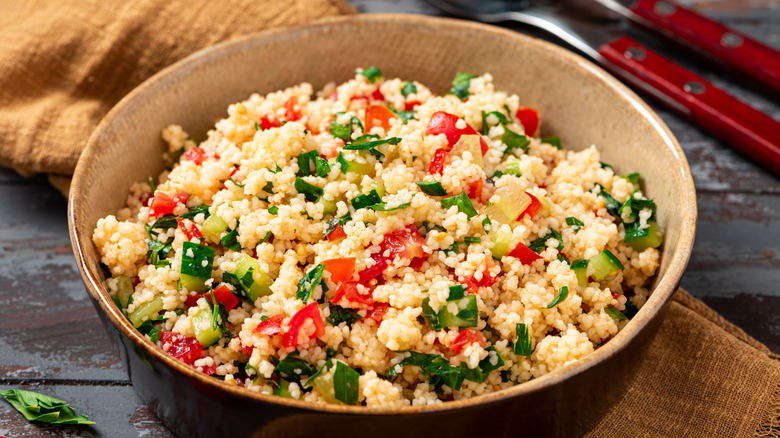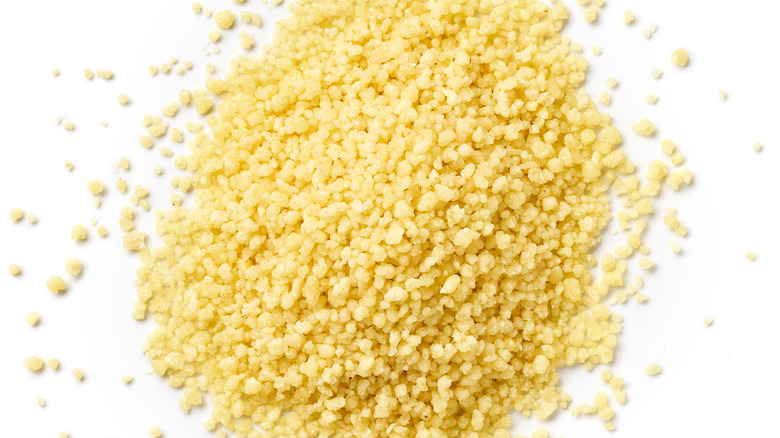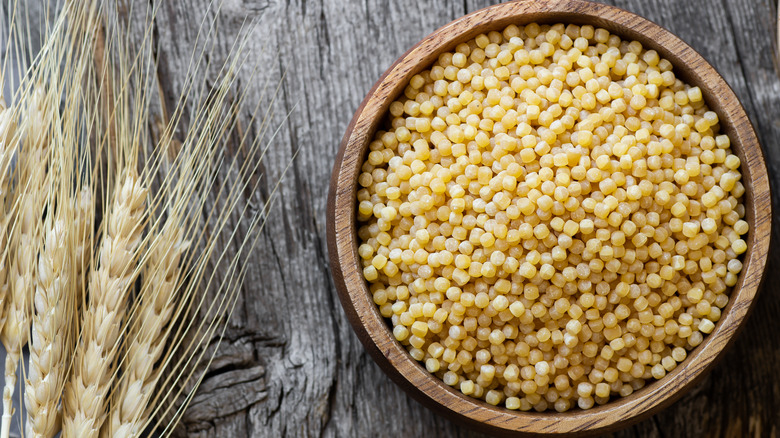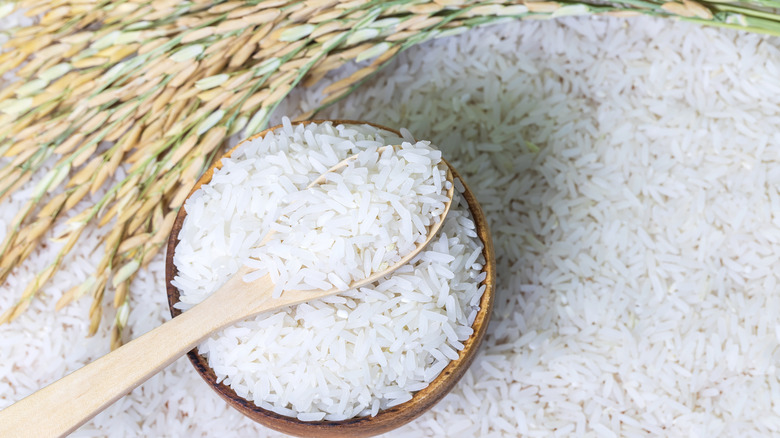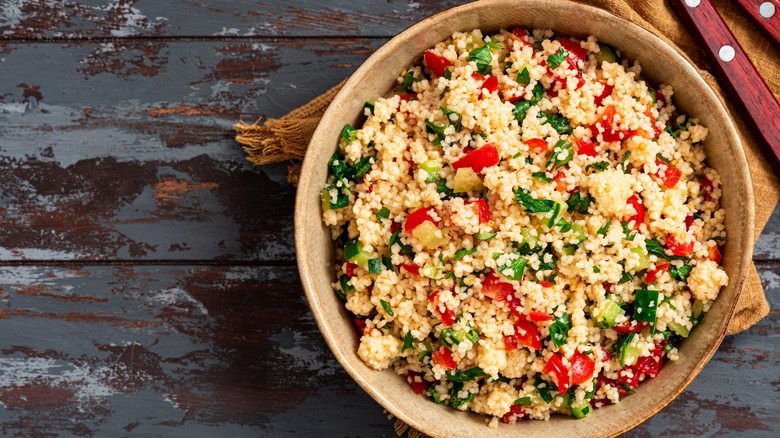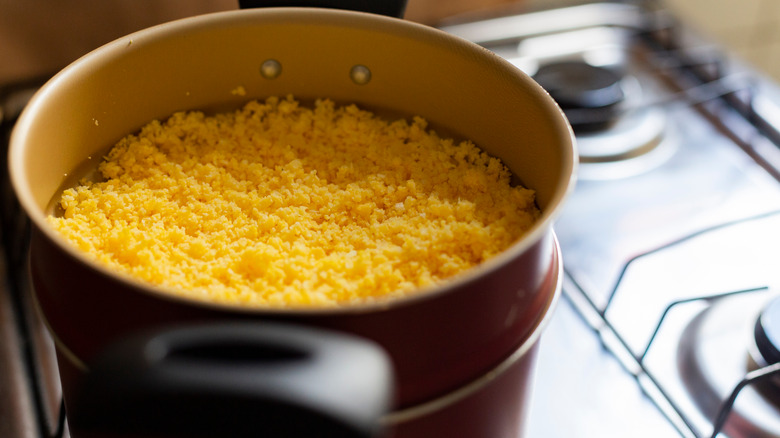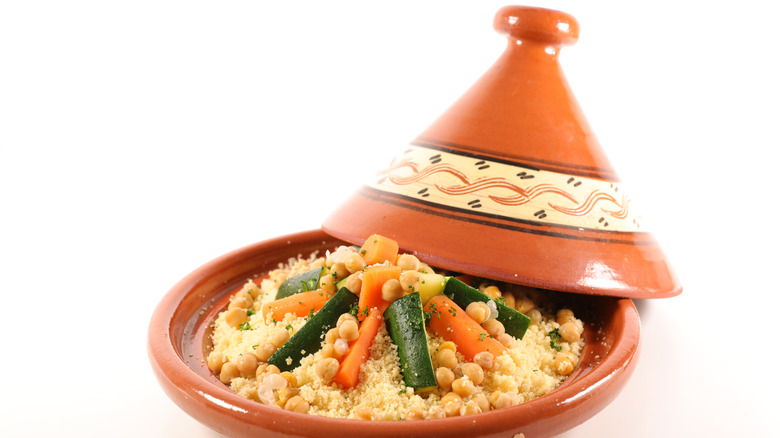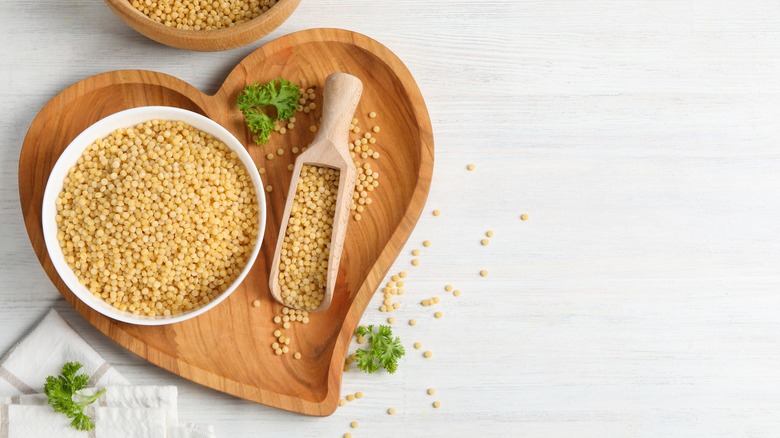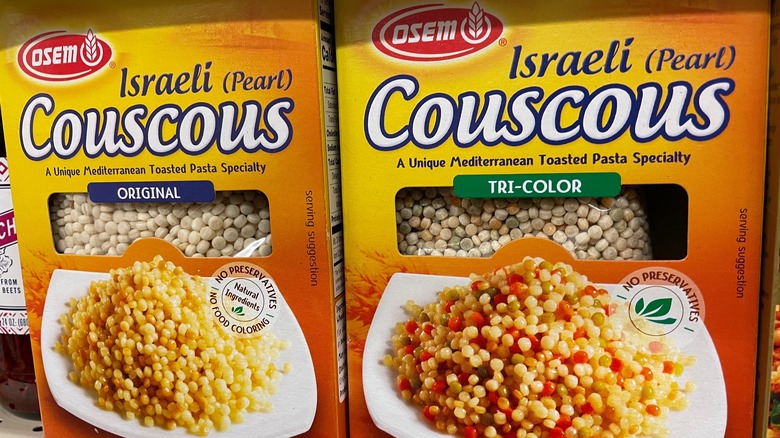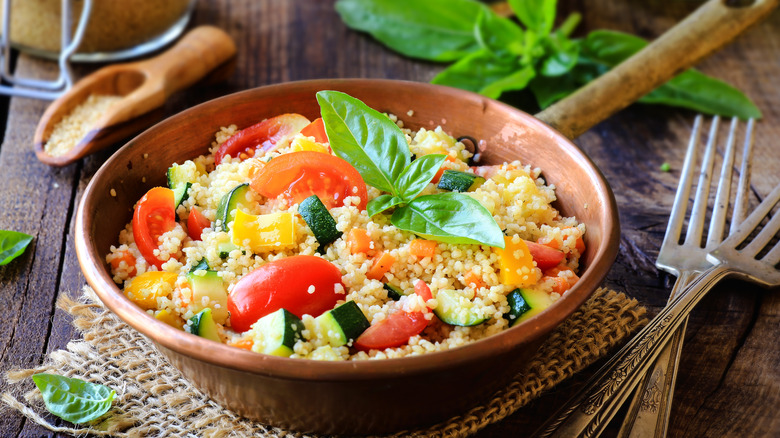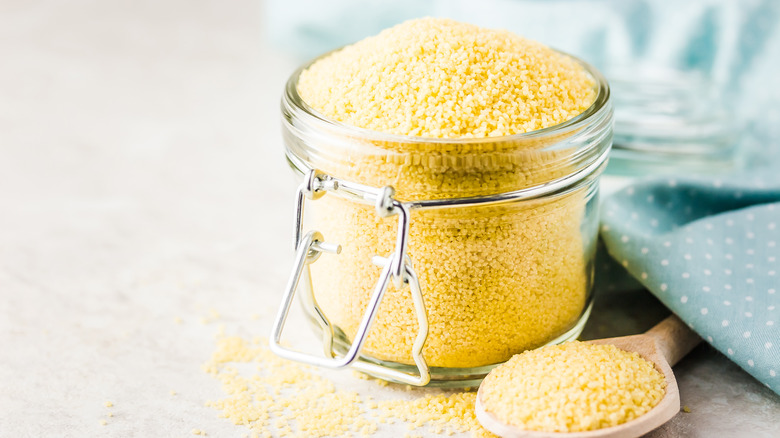A Guide To Couscous, For The Uninitiated
Join us on a fascinating journey into the world of couscous, an inexpensive pantry staple that has become a popular addition to meals worldwide. Often considered to be a trusty sidekick to the main event of meat or fish, couscous is capable of stepping into the spotlight and becoming a light main course of its own with the help of a few well-chosen ingredients.
Its delicate spheres, made from the ground form of durum wheat (Triticum durum), provide the perfect blank canvas to soak up flavors from vibrant herbs, warming spices, and rich sauces to create mouthwatering dishes across various cuisines.
From its origins in Northern Africa to its growing popularity in Europe and beyond, couscous has proven to be an adaptable ingredient capable of holding its own against similar favorites such as rice and quinoa.
Whether you are a couscous aficionado or taking your tentative first step into new territory, let's unpack everything you could possibly need to know about couscous. Through our comprehensive guide, we hope to inspire you to delve deeper into the joys of couscous and add more adventurous versions of this dish onto your plate.
What is couscous?
Before we delve into the modern uses and cultivation of couscous, let's journey back a few centuries. Though its origins are somewhat debated, the history of couscous can be traced back to the vibrant landscapes of Northern Africa, sometime between the 11th and 13th centuries. A popular dish with the native Berber people, the word couscous comes from the word 'seksu,' which means well-formed in the Berber language (via the Journal Foods).
Easy to cook and happily taking on a variety of flavors, couscous was a staple in North Africa during the last millennium. It gradually made its way out of the continent, becoming popular in Mediterranean Europe and eventually across the globe.
So, now to the burning question — what exactly is couscous? Well, prepare for a culinary revelation as this well-known grain is not, in fact, a grain, but a form of pasta! It is made from finely ground semolina flour — derived originally from durum wheat — mixed with water and rolled into small spheres. However, when cooked, couscous has a light, fluffy texture that distinguishes it from traditional pasta and makes it similar to grains such as rice, quinoa, or bulgur wheat.
Regardless of its identity crisis, the beauty of couscous lies in its adaptability and capacity to star in a wide range of dishes and cuisines. From Moroccan tagine to French taboulé salad,couscous continues to satisfy palates across the globe.
How is couscous made?
The preparation of couscous begins with durum wheat, a hard wheat known for its high protein content and distinctive yellow color. The wheat is coarsely ground to create golden-colored semolina flour, the main ingredient of couscous. Water is then added to moisten the flour, which is rolled into tiny, uniform granules. Traditionally, a sieve removes larger spheres, which can be re-rolled to match the smaller ones in size and shape, before being left to dry in the sun.
Since couscous has gained global popularity, the preparation process has been industrialized, and the equivalent of a giant food processor mixes the semolina with water to create the dough before rotating to produce the delicate pearls.
These granules are then mechanically steamed and pre-cooked, making them 'instant' and reducing the cooking time for consumers. Instant couscous is a modern revelation that allows us to fit this traditional dish into our busy lives, requiring only the addition of hot water to prepare.
However, similar to hand-making Italian pasta yourself, if you want a more authentic experience, making your own hand-rolled couscous will be worth the effort. Whether you have the time to prepare authentic couscous from scratch or opt for a quick and easy instant meal, couscous can be enjoyed as a midweek meal or a gourmet feast, meaning there is a place for it in every home.
Couscous vs rice
Couscous and rice often accompany similar dishes, serving as a hearty base for various meals. Their unassuming and adaptable tastes allow them to subtly complement the other flavors on the plate, from roast meats to stir-fried vegetables. Though they have similarities, understanding the distinction between couscous and rice can help you choose the perfect partner for your next meal.
While couscous is not a grain, when cooked it has a fluffy texture adept at soaking up sauces and dressings. In contrast, rice stands as a true grain, from the plant Oryza Sativa, which is actually a type of grass. The texture of rice can vary significantly, from the sticky delight of sushi rice to the comforting embrace of risotto.
Since couscous contains gluten, it is off-limits for those with Celiac disease or following a gluten-free diet. Rice, on the other hand, is gluten-free and a good alternative to couscous and wheat-based grains.
Couscous is abundant with protein, containing 6 grams (1 cup) per serving. It also has a wide range of vitamins and minerals, including selenium, needed to help cells prepare against damage. While rice doesn't shine quite so brightly in the nutrition department, it does contain fiber, particularly brown rice, which has most of the grain intact. Couscous and rice can be used interchangeably in many dishes, offering a chance to mix up your favorite meals and try a new pairing.
What does couscous taste like?
As a popular accompaniment to dishes across many cuisines, couscous is an adaptable culinary star, ready to mingle with a vast tapestry of tastes and textures. On its own, couscous has a mild flavor with nutty qualities due to the semolina it comes from. In the same way that most people do not eat pasta on its own, couscous benefits from combining with other flavors — a blank canvas that can pair with other star ingredients to create a delectable dish.
The texture of couscous, when cooked well, is light and fluffy, meaning it can be used in salads or as an accompaniment to meat dishes if you don't want a heavy, stodgy meal. As a salad, vibrant fresh flavors, such as tomatoes and bell peppers, work well for a pop of freshness with every bite. In Middle Eastern dishes, pomegranate seeds and dried fruits often make an appearance, too, creating a surprising flash of sweetness throughout a savory dish.
As an accompaniment to a main meal, the couscous will soak up sauces wonderfully, and herbs such as cilantro or mint will shine through and create a zingy, fluffy delight. Its versatility is what makes couscous such a ubiquitous ingredient in many global cuisines. Whether soaking up the rich sauce in a Moroccan tagine or complementing feta and olives in a Greek salad, couscous is a reliable staple that can turn its hand to almost anything you ask of it.
How to cook with couscous
Couscous is an adaptable and versatile ingredient, but cooking it properly is crucial in keeping its title as the humble hero of a dish. The beauty of couscous is its light, fluffy texture, which will be lost if cooked improperly. There are two ways to make couscous, depending on whether you are cooking fresh, handmade couscous or instant couscous.
Hand-made couscous should be steamed, not boiled. This prevents the delicate grains from becoming waterlogged and sticky and creates the perfect fluffy texture synonymous with couscous. The best way to steam couscous is in a double boiler called a couscoussier. The bottom pot can be filled with flavorsome stock or the meat stew accompanying the couscous. As a result, the couscous in the top section will absorb the delicious flavors from below as they infuse with the steam.
Traditional cooking of couscous involves soaking it in water, rubbing it between your hands, and then steaming it in the couscoussier for five minutes. Repeat once or twice until the couscous is cooked and has a fluffy texture.
Cooking instant couscous is a simpler affair, which is why it has become a popular commodity in our hectic, non-stop culture. Instant couscous is pre-cooked, meaning the time spent standing over the stove is lessened considerably. For extra flavor, try cooking it in stock rather than plain water. Cook the couscous in a pot for five minutes, then fluff with a fork to create the perfect consistency.
Traditional recipes for couscous
In North African cuisine, couscous is often coupled with meat such as lamb or chicken, a hearty gravy, and plenty of fresh vegetables. A few raisins and almonds may even make an appearance, adding a delightful crunch of texture and sweetness.
In Mediterranean Europe, couscous often takes a more refreshing twist, served with zesty lemon, juicy tomatoes, and plenty of fragrant fresh herbs. The adaptability of couscous gives amateur chefs the opportunity to play with combinations of flavors to find out how best to make it the star of the show.
Try making baked eggplant with lemon couscous for a great vegan lunch that will fill you up without leaving a heavy feeling in your stomach and helping to avoid the mid-afternoon lethargy. For a more traditional, filling dinner, use couscous to complement a hearty Moroccan tagine.
Spices such as cinnamon and cumin will accompany the couscous perfectly — and the fluffy grains will soak up the rich gravy to create a mouthwatering concoction. Whether you are planning a light lunch or fancy dinner, consider couscous the next time you need to make a dish that will leave a lasting impression. With its ability to seamlessly pair with so many ingredients and cuisines, it is a dish that can satisfy any palate and any occasion.
Varieties of couscous
If you're looking to mix up your couscous game, it may be worth knowing there are a few varieties that can add texture to your dishes. Knowing which couscous variety to choose is crucial for preparing the perfect dish.
Moroccan couscous is the smallest and most versatile type. Its fine spheres cook quickly, making it an ideal choice if you are pushed for time or looking for a light, fluffy accompaniment to a range of dishes.
Israeli couscous, also known as pearl couscous, is much larger than the Moroccan variety and has a different texture. Israeli couscous takes longer to cook if steaming — but it can also be boiled. The result is a pot of little pearls which are much chewier than their Moroccan counterparts. Israeli couscous makes a great salad alongside glistening pomegranate seeds and fresh vegetables.
Also known Moghrabieh, Lebanese couscous is the largest of the main varieties. Reaching the size of chickpeas when cooked, Moghrabieh is commonly used in the Lebanese stew of the same name. This hearty, healthy stew consists of aromatic spices and slow-cooked meats, and complements the large couscous well.
While couscous contains gluten since it comes from durum wheat, gluten-free varieties do exist. Typically made from corn rather than wheat, these varieties may be harder to find, and you may have to try a specialty store. Moroccan couscous is the most common variety, but it's worth considering other types to increase your culinary repertoire and add further couscous goodness to your week.
Where to buy couscous
If you're planning to add couscous to your weekly meals or put it on the menu for your upcoming dinner party, it helps to know where to find it in your local store. Although we have discovered that couscous is technically a pasta, in most stores you won't find it in the pasta aisle. Instead, it is likely to be located near grains such as rice, quinoa, and bulgur wheat. This is because couscous tends to be used in the same way as these staples and can be easily interchanged with them in most dishes.
Moroccan couscous will commonly be available in your supermarket and most stores in instant form, or you can buy semolina in the baking section if you fancy making your own. Israeli and Lebanese couscous may be trickier to get your hands on, though your local store may stock them in the World Foods section. Otherwise, head to a Middle Eastern store that will have a wide range of couscous varieties to help you make more adventurous dishes.
In our digital age, a range of couscous varieties are available at the click of a button, whether you are looking for a particular brand or want a gluten-free option. Online stores such as Amazon and whole food stores can deliver the exact couscous you want, giving you more time to focus on the cooking!
Nutritional information about couscous
Couscous is often considered a healthy option in the world of grains. Compared to refined grain products such as white pasta and bread, it packs a bigger nutritional punch, making it a good option for those seeking a healthier alternative.
Couscous is a rich carbohydrate source and often takes the place of potatoes or rice on the plate. Whole grain couscous is an unrefined carbohydrate, meaning it takes longer to be absorbed into the bloodstream than refined carbs and is less likely to cause a sharp rise in blood sugar. Replacing refined carbohydrates in your diet with whole grains can reduce the chance of developing diseases such as type 2 diabetes. The high fiber content of couscous will also help you feel fuller for longer, narrowing the chance of you snacking on sugar snacks later in the day.
Couscous is also a great source of plant-based protein, making it the ideal choice for vegetarians, vegans, and those trying to add plant-based foods to their diet. It's rich in a number of vitamins, including B vitamins such as niacin and thiamine, and minerals such as manganese and selenium.
With the availability of instant versions, couscous has become the ultimate fast food, but without the adverse health effects of an order from your local take-out. Its nutritional profile also makes it a great alternative to rice and other grains to help you mix up your midweek meals.
How to store couscous
After the effort you have gone to in tracking down your couscous in the store or preparing a delicious meal, you want to make sure you store it properly to maintain its freshness and flavor.
Before opening your pack of couscous, store it in a cool, dark cupboard away from moisture. Upon opening, it is best to transfer it to an airtight container to keep it dry and prevent mold from growing. You may even want to keep it in the fridge if you live somewhere very hot. Dried couscous should last for one to two years in a cool dry place — like dried pasta and rice, it usually is safe to eat beyond its best-before date.
For leftover cooked couscous, allow it to cool and then store it in an airtight container in the fridge. It will stay fresh for around three days, or you can freeze it if you want to keep it for longer. Previously cooked couscous can be reheated on the stove or in the microwave, making sure it is piping hot before eating.
As with any culinary venture, common sense should be used as these guidelines are not set in stone. If your couscous looks or smells strange, it is best to throw it out. It is not worth the risk of food poisoning when you can easily whip up another batch for tomorrow's lunch.

